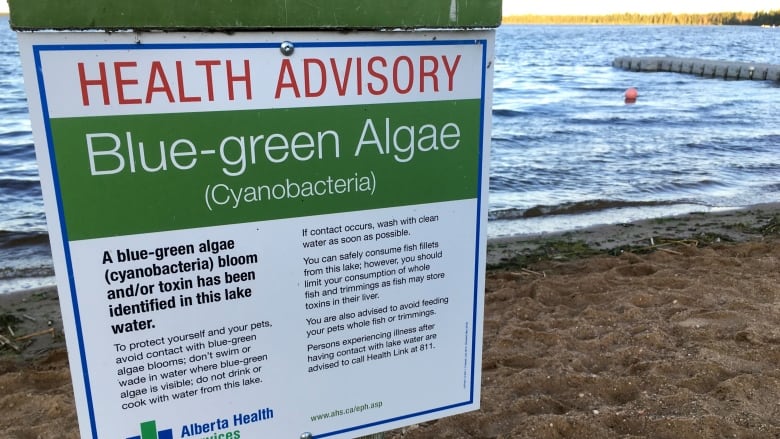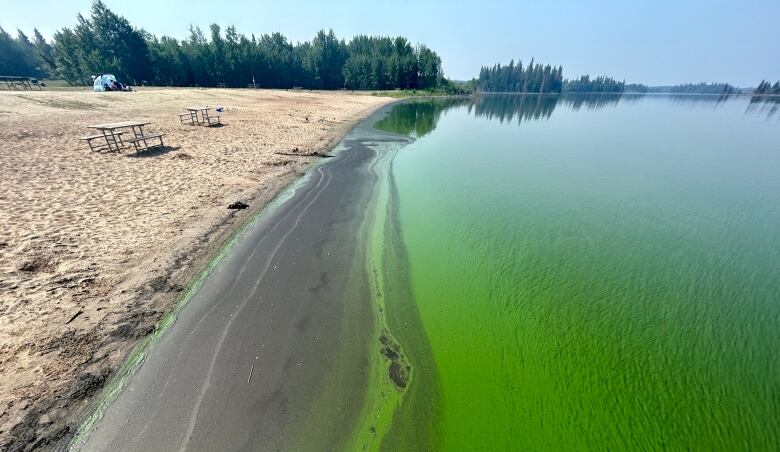Blue-green algae could be coming to a lake near you as Alberta heat wave continues
Blooms can be harmful to people and deadly for pets

Albertans are being warned to be on the lookout for potentially toxic blue-green algae in lakes as an ongoing heat wave creates prime conditions for the blooms to thrive.
Blue-green algae, or cyanobacteria, occurs naturally and can look like grass clippings or green powder floating on the water's surface. Blooms can also look like scum, fuzz or globs and come in less common colours, including brown and red.
"'It's not an exaggeration, we probably haveover a hundred different species of blue-green algae just in the province," said RolfVinebrooke, a professor in the department ofbiological sciences at the University of Alberta, who studies blue-green algae.
"But the bad boy list is probably only your top 10 or so. All the other ones are relatively benign."
Some types of cyanobacteria produce toxins that can make peopleand animalssick.
"If they're very abundant, they pose a potential risk," said Vinebrooke.
Health advisories have been issued for more than a dozen lakes around the province so far this summer.
Health risks
According to Health Canada, exposure can lead to health problems, including skin irritation, gastrointestinal symptomsand headaches.
The type of symptoms people experience directly relates to how they're exposed to the cyanobacteria, according to Dr. Kathryn Koliaskaof Alberta Health Services.
"If the water gets on someone's skin, you might get a rash. You might get itchiness.If it's your mouth and nose and face, you might have burning lips," said Koliaska,lead medical officer of health for safe healthy environments.
"If you swallow that water, then those problems can go into your digestive system, causing stomach aches, diarrhea. As well,if there's a large amount or over a long period of time,[it causes] problems with other organ systems in the body."
- Alberta scientists tracking blue-green algae blooms using satellite imagery
- What you should know about toxic blue-green algae blooms
In more severe cases, organs such as the liver and kidneys can be damaged. Other serious problems include respiratory failure, according to Health Canada.
While death is rare among people, the website says, deaths among animals,including dogs, is more common.
Koliaska said children are particularly vulnerable due to their smaller size and the likelihood they may inadvertently consume water, even when they're wading.
She urged vigilance and said anyone with concerning symptoms should seek medical care.
"The first advice is be on the lookout for it," she said, adding blooms may not always be visible.

Health advisories
AHS monitors approximately 40 bodies of waterthrough the summer season and posts health advisorieswhen cyanobacteria is present.
Koliaska said Albertans can also notify officials through environmental public healthif they suspect blue-green algae.
Some speciesthrive in hot temperatures, according to Vinebrooke,and the frequency of health advisories has pickedup as the weather warmed up this month.
"Just like plants, if you give them adequate amounts of nutrients, you give them adequate amounts of sunlight and you compound that with giving them nice, warm growing temperatures, then they're apt to really kind of take off and cause these problematic blooms that you see becoming more and more frequent right now as the temperature starts rising in the lakes," he said.
- Blue-green algae: harmful for humans, fatal for dogs, warns Edmonton vet
- Potentially toxic cyanobacteria blooming early in St. John River, expert says
As of Friday, AHS had issued 15cyanobacteria advisories since the start of the season.
Vinebrooke expects the latestheat wave will spark a further flurry ofalerts in the next few weeks.
"It doesn't necessarily bode very well for people wanting to use lakes because this could really fuel the growth of blue-green algae," he said.
"I'm thinking August mightkind of not be the greatest month for lake water quality."
Health officialsrecommendstaying out of affected waterand to refrain from swimming and wading. The same advice applies to pets.
If you do come in contact with contaminated water, theyrecommend rinsing off with tap water as quickly as possible.
The health authority is also reminding Albertans to avoid drinkingor cooking withuntreated water at these sites and to limit consumption of whole fish and fish trimmings from the lake.












_(720p).jpg)


 OFFICIAL HD MUSIC VIDEO.jpg)
.jpg)



























































































